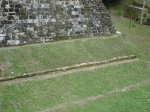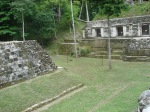Imagine the scene. The stands are packed. The crowd is glued to every move made on the court. Elite athletes focused. A ball hurtles toward the dirt, your hero dives for it, deflecting the heavy rubber ball with his shoulder. His opponent springs into the air, and the ball comes right back. Again he dives. The ball slams into his hip. He grunts at the heavy thud of the ball against his skin. He twists and wriggles in the air, defying gravity. You watch. mezmorized as the ball sails over the opponent’s head, out of reach. The crowd erupts. Score!
Sound like the nail-biting finish of a world-class soccer game? How about the winning play of an ancient Maya sport called pitz, in which the stakes were life and death. As more and more of the Maya hieroglyphic texts are read, new insights into their civilization come to light daily. Few aspects of Maya culture reflect their beliefs as concretely as the ball game. Such games were central to cultural life in ancient Mexico.
Archeological evidence throughout southeastern Mexico, Guatemala, Belize, and Honduras suggests that people there played a game with a rubber ball beginning about 300 BC. Spanish Conquistador Hernan Cortés witnessed the descendants of the ancient Maya playing a game with a rubber ball in 1528. He and his men were so fascinated by it that they sent two full teams back to Europe to play for King Charles V.
Much of what we know about the ball game comes to us from chroniclers who witnessed the game being played in Maya cities at the time Europeans first encountered the ancient people of Mexico. Although the rules of play may have varied, Mayanists agree that the ball game was an important part of both the spiritual and communal life of Maya society.
Archeologists have found the remains of ancient ball courts in every Maya ceremonial center. The Maya built them big and small, in cities carved out of the rainforest. Some have plain stone walls while others are adorned with elaborately carved murals. Often the murals showed the mythical Hero Twins Hunapu and Xbalanque, who played the game against the lords of the underworld. All over the Maya and Aztec region, Kings built ball courts right in the middle of their cities. All of them look like our capital letter “I” or” T”
The Court
The court had three parts. The main alley was marked by stones or bounded on both sides by walls or tall benches. At the ends were wider sections that served as end zones. Players passed the ball back and forth between the two teams using only their hips, arms, chests, and buttocks. If the court had walls, they could use the walls to make it harder for the other team to return the ball.
A team scored a point in one of three ways: If your opponent used his hands, feet or head; If the ball went into your opponent’s end zone; And, the hardest way of all, if your team shot the ball through one of several rings, high up on the walls of the central alley. When that happened, the game ended and the team that made the shot won.
The Ball
The Maya made the ball by boiling the sap, or quiq, of certain local trees in water mixed with herbs. They rolled the mixture into a sphere. When it hardened, depending on its size, the rubber ball could weigh up to eight pounds. Players wore special equipment to protect themselves from the ball as it hurtled around the court. Leather straps on the backs of their hands and covering their buttocks protected the skin. They wore chest protectors, stone belts, and collars to protect their stomachs and throats. Some players even wore helmets and goggle-like eye protectors. Playing the game in the most important matches required great skill, and the most successful ballplayers were local heroes. They were respected members of the society. Their names were written on ceramic vases and stone inscriptions so they would be honored for all time.
The ball game served many different purposes. Boys and young men often played in their spare time for fun. Teams from different villages and cities competed with each other in regional rivalries much like sports teams do today. Hundreds of people watched these matches and the spectators bet on the outcome of the games. The losers and their supporters often went home without their jewelry, clothes, and shoes. Sometimes the losers were forced into slavery. Most games played in the cities of Mesoamerica were played for sport and the enjoyment of the spectators, but the purpose of the most important games had religious meaning.
Those games commemorated the game played by Xbalanque and Hunaphu, twin hero gods of Maya mythology, against the cheating lords of the Maya underworld, the Xibalbans. In that game, Xbalanque and Hunahpu beat the unsportsmanlike Xibalbans, using their skill as ball players, their wits, and the help of animals and insects of every kind. To honor the victorious twin gods, ritual games were played in which the outcome was predetermined. The losers, usually kings or nobles captured in wars, were sacrificed in a ceremony following the game.
The Maya and human sacrifice
To the Maya, the gods’ most precious gift was human life. It was a sign of supreme respect to offer a human being to the gods in sacrifice. Rarely, however, did they sacrifice people from their own communities. Usually, prisoners captured in wars with neighboring kingdoms were offered to the gods as evidence of the king’s power and his right to rule. In fact, acquiring captives for ritual sacrifice was one of the main reasons Maya kingdoms went to war. Victories in battle were almost always followed by a ceremonial ball game in which the prisoners played the final game of their lives.
In modern Mesoamerica, communities play a game similar to the one played by their ancient ancestors, with one important difference. After a modern game,everyone goes home with his or her head still on.
Check out this link to an ancient sculpture of the crowds a
http://www.worcesterart.org/Collection/Precolumbian/1947.25.html



